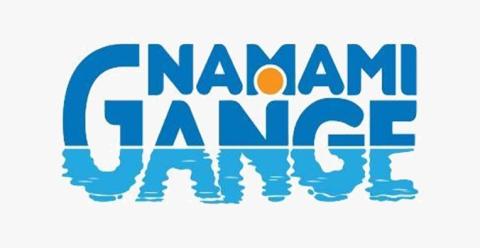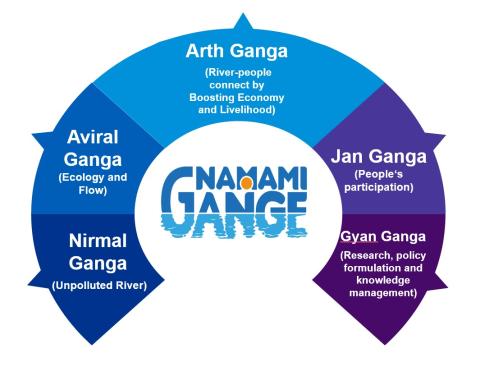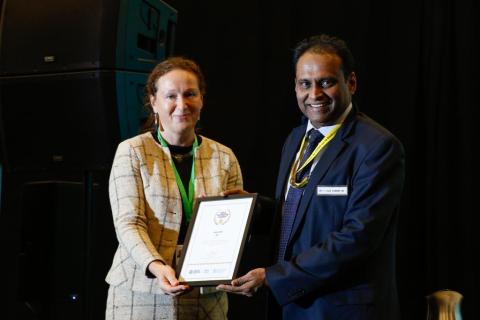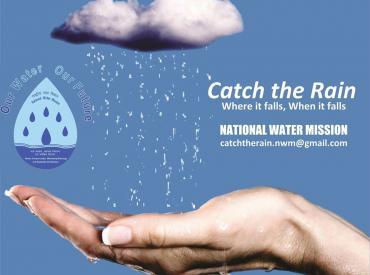


G. Asok Kumar superannuated on 29 February 2024, as Director General of the National Mission for Clean Ganga (NMCG) in the rank of Secretary to Government of India. NMCG is the implementing agency for the “Namami-Gange ”, a flagship program of Government of India, announced in 2014 to clean and rejuvenate River Ganga and its tributaries. During his tenure, Namami Gange scaled new heights and won many accolades; got recognition from UN as one of the top 10 “World Eco- Restoration flagships” at the CoP 15 of Biodiversity at Montreal on 13th December 2022. This is a very big achievement, considering that this was done after UNEP and FAO led UN Decade examined over 160 eco restoration programs across the world. The programs were examined on "their effectiveness and success to halt the environmental degradation, reverse the environmental degradation, that too with people’s active participation", among other things.
G. Asok Kumar has been associated with NMCG since 18 February 2019, first as Executive Director (Projects) and then as Director General.
In his tenure as Director General from 1 January 2022 to 29 February 2024, completion of projects saw a significant jump. Compared to 993 Million Liters Daily (MLD) sewage treatment capacity (in 74 Projects- 62 in Main-stem and 12 in tributaries) created in the Ganga Basin under Namami-Gange in the 8 year period from 2014-2021, additional 2593MLD treatment capacity (in 60 projects) was created in 2 years and 2 months! Another 350 MLD treatment capacity is scheduled to be completed by 31 March 2024. That would be 2936 MLD or about 3000 MLD in 2 years 3 months period!.
This has resulted in improved quality of water in the river, INDICATED by : (1) the reduced number of polluted river stretches seen in reduced BoD (Biological Oxygen Demand) levels (<3 milligrams/liter); increased DO (Dissolved Oxygen) level (>5mg/lt) as reported by CPCB (Central Pollution Control Board) ; (2) improved bio-diversity (increased sightings/sighting-river stretches of Dolphins, Otters, gharials etc) as reported by Wildlife Institute of India and villagers on the banks of the rivers and (3) the positive appreciation from the pilgrims who take dip in River Ganga.
Namami Gange was launched for 5 year period with a committed budget of Rs 20,000 Crores. This was further extended to 2026, with Rs 22,500 Cr budget. The program, when launched in 2015 based on the National Ganga River Basin Management Plan (NGRBMP) prepared by a consortium of 7 Indian Institutes of Technology (IIT)s, led by IIT, Kanpur, had 4 pillars- the Aviral Ganga (the unrestricted flow), Nirmal Ganga (unpolluted flow), Gyan Ganga (Knowledge management) and Jan Ganga (People’s participation). In 2019, on the suggestion of Hon’ble PM at the 1st National Ganga Council Meeting in 2019, another pillar ie Arth-Ganga (River people connect using an economic bridge) was added. Asok Kumar handled the 1st meeting of the National Ganga Council on 15 December 2019 at Kanpur as ED (Projects) and the 2nd meeting of National Ganga Council on 30-December-2022 at Kolkota, as DG, NMCG.
For more details on Namami Gange Program please visit http://nmcg.nic.in
For the significant improvements in the outcome of NGP, some of the initiatives of G. Asok Kumar include:
In his tenure as Director General from 1 January 2022, completion of projects saw a significant jump. Compared to 993 Million Liters Daily (MLD) sewage treatment capacity he would be creating a sewage treatment capacity of 2936 MLD or about 3000 MLD in 2 years 3 months period!.
Asok Kumar could achieve this due to closer, tighter, frequent monitoring of the projects and frequent site visits; and pro-actively engaging with all stake holders (state governments, municipalities, departments of power, public works, forest etc in the state and Ministries of Railways, Defence, Environment and Forest and Climate Change, National Highways Authorities of India (NHAI), Cantonment boards in the Government of India ) to remove the bottle-necks in the form of long pending-permissions; delay in taking decisions; issues related to site and land etc. This led to speedy completion of large number of projects, some started as early as 2015! Training programs/capacity building exercises of officials at the local level were taken up and Decentralized monitoring by empowered District Gang Committees encouraged for better and faster implementation.
Improved transparency and quicker decisions have facilitated in better participation of bidders and hence competitive biddings for the tenders floated by Namami Gange. From 3-4 participants which used to be the case in Tenders earlier, the number of bidders have significantly increased. The Meerut bid had 19 bidders and the Indore bid had12 participants. In all the bids, there are not less than 6 bidders now! This shows the confidence of the bidders and their trust in the management of Namami-Gange under the leadership of Asok Kumar.
With these Sewage Treatment Plants (STPs) or recently reimagined and re-branded as Nirmal Jal Kendras (NJKs) and the industrial effluent treatment plants constructed with NMCG funds, the river water quality has improved very much. All along the 2525 kms main stem, the dissolved oxygen levels are much above the mandated, Minimum prescribed level of 6 mg/liter. There are only 2 small stretches, with Biological Oxygen Demand (BoD) more than the maximum mandated level of 3 mg/liter. This has resulted in increased biodiversity- with more sighting of Dolphins in more stretches, more otters and Gharials etc. As per the reports of Wildlife Institute of India (WII) the number of Dolphins have gone up from 2000-2200 in 2018 to 4000-4400 in 2023. Dolphins and their juveniles are being sighted even in tributaries
A dash board PRAYAG- (Platform for Realtime Analysis of Yamuna, Ganga and their tributaries)- was launched on 20 April 2023, which monitors the functioning of about 175 STPs 24 by7. Realtime reports from 308 STPs on the banks of the rivers Ganga is captured every 15 minutes at the central server in PRAYAG. Moreover, 110 sensors to monitor river water quality sends periodic reports to the server. SMS notifications are sent to the authorities concerned, if there are failure in quality performance. This was a major step in ensuring that the STPs and CETPs constructed are functional and operated 24by7, putting an end to earlier practices of non-operation of STPs to reduce the O&M costs. Live Feed cameras from 50 STP projects are also being implemented. A sophisticated Ganga Monitoring Aqua Lab is set up in Wildlife Institute of India, (WII), which is given a project to do the ecological assessment of Ganga basin.
PRAYAG has many GIS based information portals. Apart from the Realtime water quality monitoring, it has geotagged the details of the location of (a) all STPs built with all sources of funds- state, central, (b) all Grossly Polluting Industries in the Ganga basin; (c) all drains falling into the river Ganga, most of which have been tapped & d) digital mapping of all utilities in 172 towns in Ganga basin (being added in phases). In addition to this, on 28 February, 2024 Digital "Kilometer stones" were added on the GIS map of the central line of the mainstem Ganga, accurately marking digitally latitude-longitude details of every kilometer distance from the Origin of Ganga to Ganga Sagar, where it meets the Bay of Bengal. This is the first time such an initiative is taken on any river in India. Division of the river into one kilometer segments, helps in close monitoring of the river.
As for the Aviral Ganga or ensuring continuous flow of environmental flow of water in the river, detailed studies for the notification of the e-flow was taken up with the help of technical experts from GIZ. After 2 years of study involving many stakeholders, they have submitted a final report in November 2023, which is under examination.
District Ganga Plans were prepared for 4 districts, with the guidance of GIZ and WWF, and released on 21 November 2023. A River Basin Management Unit was set up in NMCG on 3 December 2023, to co-ordinate the implementation of these and the Ram-Ganga River Basin Management plans, prepared with wide ranging of consultations with stakeholders in the year 2022-23. RamGanga is a very important tributary of River Ganga and this is the first step towards decentralized river basin management, proposed to be taken up for the sustainability of the efforts of NamamiGange involving all stakeholders.
Many initiatives were taken to improve the urban water and river management. River cities alliance launched with 20 Ganga basin cities on 25 November 2021, grew to a mammoth organization with143+ cities on the banks of various rivers in India as members by February 2022. It was expanded and launched as "Global River Cities Alliance" on 10 December 2023, at the CoP28 meeting in Dubai. On 6 December 2023, Asok Kumar, on behalf of River Cities Alliance, signed a Memorandum of Common Purpose with the 124 member Mississippi River Towns and Cities Initiative (MRTCI) of the USA.



 ,
, 
 ,
, 

 ,
,  ,
, 
 ,
, 



